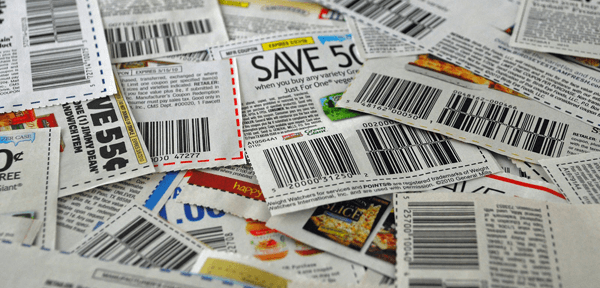10 Grocery Store Hacks to Save You Money
By: Lucy Zemljic on October 30, 2014
Have you ever found yourself with a suddenly-full shopping cart, thinking I only meant to buy bread and milk? Or had a case of sticker shock at the checkout, when the total came up to more than you bargained for?
It’s happened to most of us at one time or another – overspending on groceries is all too easy. The good news? There are plenty of things you can do to shop smarter at the grocery store. Here are ten supermarket hacks to help stretch your hard-earned dollars further.
Before You Shop
1. Plan your meals for the week.
Figuring out your meals for the upcoming week can really cut down on impulse purchases and wasted food. Set a few minutes aside to come up with meals for the next seven days. Try to incorporate ingredients that can be used in multiple meals, like produce and dairy, so none of your perishables go to waste.
Leaf through weekly fliers and clip any coupons – planning your meals around deals and sales will trim a considerable amount off of your grocery budget.
2. Make a list and stick to it.
“The list is the origin of culture,” said renowned author Umberto Eco. We don’t know much about the origin of culture, but we do know that lists make life easier, especially when shopping for groceries.
After you plan your meals, make a list of what you need for the week’s recipes, and stick to it. Stepping into a supermarket without a list leads to impulse shopping.

When You Get to the Grocery Store
3. Be mindful of grocery store mind games.
Food experts and industry analysts have spilled the beans on supermarkets. As it turns out, product placement and store layout is no accident – grocery stores are actually designed to get you spending more.
It’s no coincidence that when you first step into your local Superstore or Loblaws, you're greeted with sensory overload.
“We’re very aware of the role that the senses play in marketing,” says Paco Underhill, consumer expert and author. “When you walk in the door, you smell bread baking or rotisserie chicken roasting in the deli area because we know those smells get your salivary glands working. When you’re salivating, you’re a much less disciplined shopper,” explained Underhill.
Don’t be tempted to ditch your carefully-planned list, no matter how enticing that slow-roasted chicken looks. Be mindful of the fact that things are laid out to get you to spend more.
When You’re Browsing the Aisles
4. Start in the middle, then head to the back, then the front of the store.
Just like the deli and bakery sections, flowers and fresh produce are also strategically placed at the front. The bright colours put shoppers in a good mood, inspiring them to buy more. When shoppers start their trip at these high margin departments, their carts are empty, their spirits are high, and they’re more likely to spend.
To keep from getting lured in by delicious sights and smells, start in the middle of the store and stock up on boxed and canned foods. Next, make your way to the back – dairy products and other essentials are usually hidden at the back, so that shoppers need to go through the whole store to get them. Finally, stock up on plenty of fresh produce and greens after you’ve visited other departments. If you get your healthy food first, you’ll be more inclined to splurge on unhealthy options later.

5. Stick with seasonal.
Peach cobbler in November sounds delicious, but getting those peaches off-season will cost you. To save money on fruits and vegetables, stick to seasonal produce. Modern technology and shipping has allowed grocers to stock almost anything at any time, but convenience comes with a price tag.
To keep from overspending, use an availability guide and stick to what’s in season. Right now, it’s prime time for fall favourites like cranberries, sweet potatoes, squash and of course, pumpkins.
6. Go with generic.
Generic and store brands are usually much cheaper than name brand products, and are just as nutritious. To save big money, go for generic, no-name, or store brand items – especially when buying staples like pasta, cereal, and canned goods and vegetables.
“National brands have to hike their prices up to pay off those expensive TV commercials and magazine ads,” explains consumer issues journalist Pat Foran.
Sometimes, store brand products are even the exact same as name brand – “beans that are canned for more expensive national brands are the same beans that go into the cans sold under the store's name brand,” he adds.

7. Take advantage of sales, but be smart about it.
Sales are a great way to stock up on essentials. When flour, pasta, beans and other non-perishables go on sale, it’s a good idea to stockpile them in your pantry for future consumption.
But, when scoring sale items, only buy what you need – don’t buy unnecessary products just because they’re on sale. If you grab one of everything from the discount rack, you’ll probably end up spending more money than you would have if you’d steered clear.
8. Look high and low.
When browsing the aisles, keep an eye on the top shelf and the bottom shelf. Grocery stores stock pricier items at eye level – brand name cereal, for instance, is usually stocked in the middle shelf, while bulk and no-name is placed on the bottom shelf.
9. Whip out those coupons.
You’ve clipped your coupons, now don’t be afraid to use them! To demonstrate the power of coupons, Pat Foran went to the grocery store with Canadian frugal shopping expert Kimberly Clancy. They had the exact same shopping list. The only difference? Clancy used coupons, while Pat Foran didn’t. In the end, he spent $133.89 on his groceries, while Foran only spent $23.45 – that’s a savings of $110!

At the Checkout
10. Don’t be tempted by checkout treats.
The checkout line is the most profitable area of the entire store. Don’t give in to the temptation of chocolate bars and gossip magazines while you wait to pay – or at least, get your gossip fix and then put that magazine back.


